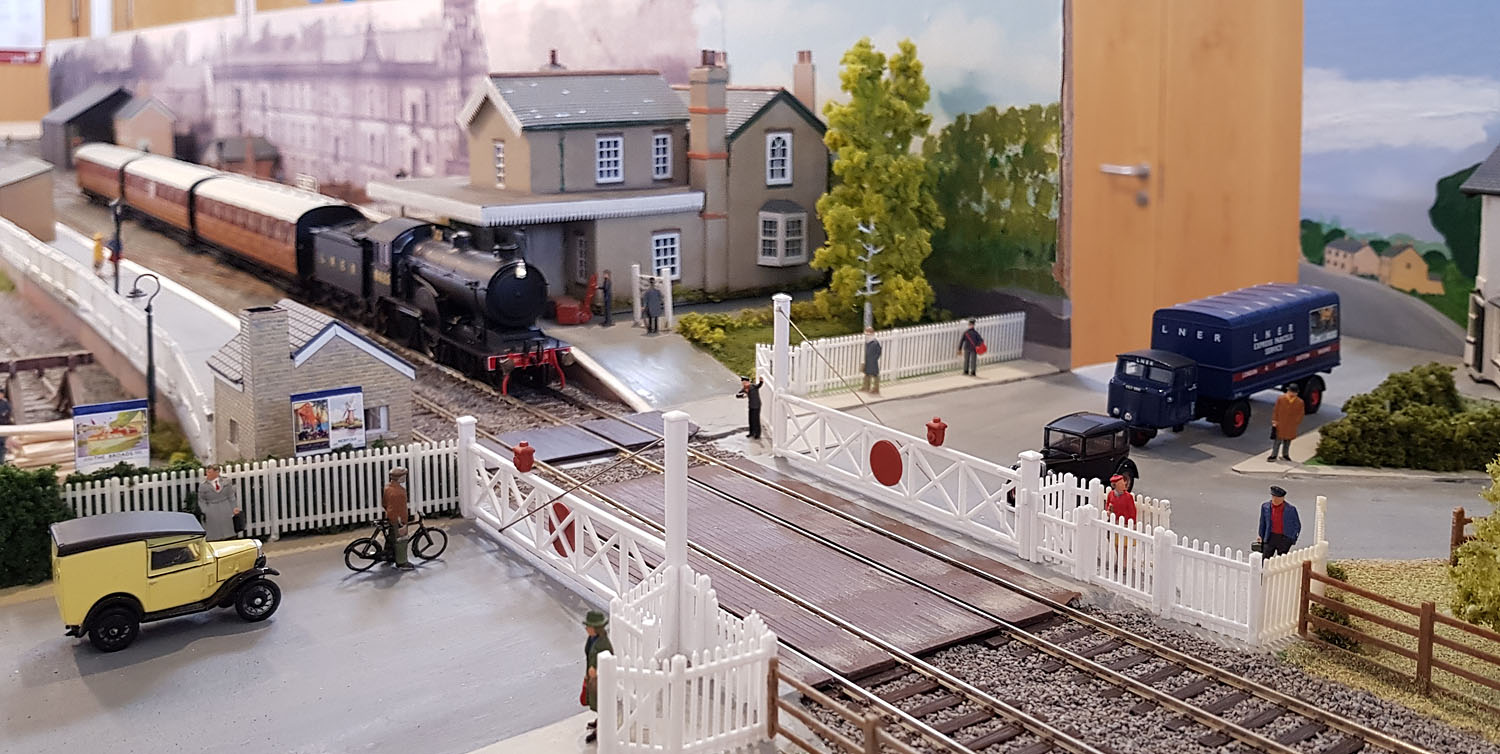 |
|
The website is arranged so that most recent entries appear at the top of the page
September 2023:
After a gap of two and a half years, its about time to present a view of where we are now:
| In Summary: The level crossing has been re-equipped with the correct 6 section gates and its original rather jerky servo drive system has been replaced with a silky smooth motor driven system which uses infra red detectors to identify the gate positions. The backscene boards are all complete and the canopies over the Chivers loading bay platforms are all in place. The coal conveyor and adjacent hoist rig have also been modelled. Most significant, the layout has now been re-configured into a large loop, with a 10 road fiddle yard behind the operators. This means that we can finally operate much longer trains. We have also re-named the layout "Rails Through Histon" to avoid confusion with the very much smaller and far less accurate exhibition model that we began with back in 2016, when we displayed it at the 2023 Cambridge MRC Exhibition. However our main focus remains on village events, with annual appearances at Feast week and now also Christmas displays.
Showing our new layout in action for it's first display at the 2023 Feast Week:
We were invited to display the layout at The Cambridge Model Railway Exhibition September 2023.
|
February 2021:
Well..... that was a surprise....
A global pandemic definitely wasn't part of our plans!.... However, before it descended upon us, the new boards had been removed from Cottenham for ballasting and further scenery work. Essential distancing and common sense precluded continuation of our group meetings and of course prevented any 2020 displays. However work on the layout and additional locomotives has continued at a somewhat slower pace and the following text and photographs describe a few of the highlights as we begin to think about coming up for air after our jabs take effect:
| The New Layout
Boards: The new boards have all now received initial cosmetic finishing, including fence work, roadways and static grass and a few trees. Platforms have been fitted for the station and for the Chivers loading bays. The mammoth task of bonding gravel ballast between the sleepers on all the track work has also been completed. Slot-in back scene boards are now covered with a sky background and ultra low relief models of the Chivers buildings that overlooked the station area are now being constructed, ready to be attached over the sky background. Working LED platform lights (based on the originals) have also been installed.
Building Updates: Recent developments of the old station area in Histon have incorporated the old station house. This resulted in the availability on line of some plan drawings of the building in its original state. A close look at these revealed a number of quite significant inaccuracies in our station house building. These have now largely been remedied by a re-build. The fairly crude impression of the South platform waiting room has been replaced with a new model derived from period photographs and the missing separate waiting room beside the station house has also been completed. The South yard office and nearby huts have been created, based on period photos and the adjacent platform fencing erected. Inspired by early 60s photos of the award winning horticultural work of the station staff, flower beds have been created along the rear of the South platform and in front of the station house. A small fill-in board South of the level crossing has enabled the Taylor's bakery and grocery store building to be added to our building reproductions, complete with Mr Taylor's delivery van (which should really be a Morris, but the Ford was the closest 10cwt we could find). Finally, although our original station signal box had an inappropriate brickwork finish between its wooden framework, it was otherwise a good reproduction of the original box. The model has now been re-clad with a more realistic simulation of its real all wood construction and repainted in its original LNER inspired colour scheme. The opportunity was also taken to replace the original interior with a new lever frame and instruments of the type used in the original box. Even the stove was re-located to its correct position! (Temporary removal of the roof reveals all, to any interested members of our display audience.)
Some additional Locomotives: A rare kit-built J69 tank engine has joined the group's locomotive fleet, ready to carry out shunting duties in our new sidings. Additional club member locos, available to participate in our displays and running sessions have also arrived over the past year. For heavy hauling, O1 and O2 2-8-0 freight locos. Additional stopping train D16/3 Super-Clauds and a new Sandringham class loco. A small LNER Sentinel steam shunter and a BR green Class 03 diesel shunter to join the J69 in the sidings. Finally, although a little fanciful in the light of our line's route availability figure..... but as a treat for ECML steam enthusiasts, a mix of Gresley A3, A4 and V2 express passenger locomotives plus Mr Peppercorn's A1 and A2 types are now available for East Coast main line diversions through our village. All the locos shown below are equipped with DCC sound systems.
Outstanding Issues: Work continues on the Chivers buildings for the back scene and will be followed by the canopies that covered the Chivers loading bays, plus the overhead coal conveyor ..... These may well still be work in progress for our next display.... time will tell! And of course there is a myriad of detailing work that will probably keep us busy indefinitely. Our plans to move towards a "big-loop" layout with a large rear fiddle yard enabling full length trains to run on independent up and down lines, have inevitably been delayed by the pandemic.... but it remains an ultimate objective for the future...... |
October 2019:
More on Layout Update Progress....
| The New Trackwork
and the supporting electrics are now installed and operational. The new boards have now been amalgamated with our existing cassette table and return loop boards at our facility in the adjacent village of Cottenham.
Next comes the scenery work: First, a set of slots will be created running around the rear of the tracked part of the board. The back-scene boards will incorporate a corresponding series of tabs along their lower edge, which will enable them to be plugged into position, but also to be removed when the layout is transported to and from displays. A combination of 3 dimensional low relief and 2 dimensional buildings is planned on the back-scene boards, to represent the massive Chivers site that overlooked our village station. Adjacent to this will run the Chivers loading bay canopies that stretched along almost the entire side of the factory. New platforms and Chivers offices are needed, but we may be able to make good use of the waiting passengers and staff plus several existing building models from our original layout. Then a significant effort will be needed to ballast the track areas and reproduce the yards and roadways on the horizontal surfaces. A lot to do before the model's first display! |
June 2019:
Layout Update Progress....
| Our Mark 2 Layout
is now taking shape!
1920s OS view of our station For sometime now we have been planning to extend our layout to add the missing Chivers and South sidings. However a new complication has prompted a more radical approach than originally contemplated. Our model is now stored in an operational state in a member's workshop, in an adjacent village. Unfortunately, the building is not heated during the winter months and the resulting environmental conditions appear to have disturbed the Sundeala board decking material. The board surface seems to have expanded sufficiently to open circuit two or three of the track joints. Remedial work has kept the trains running, but as the track is embedded in ballast, it is not possible to close all the gaps that have formed. Now summer has returned, the situation has improved, but clearly the layout would benefit from a transition to a more stable baseboard structure.
The new baseboard plan So rather than add additional boards to our existing layout, we are in the process of building a set of larger boards, using good quality 9mm plywood for the decking. When the boards are ready, new track, including the missing sidings and the curved mainline through our station, will be laid. When this is operational, as much of the scenery as possible will be transferred to the new boards and additional scenic features will be included.
The new boards coupled together and on their trestles for the first time Initially we plan to continue operation using our train cassettes and the existing return loop. However, it is clear that in the longer term, the layout would benefit from a change of configuration, to a complete main line loop, incorporating a multi-track rear "fiddle yard". This would enable us to operate longer trains (including occasional double headers) and drive at more realistic running speeds through the entire visible part of the layout.
We hope to have the new boards in operation with the existing cassette and return loop arrangements by mid 2020. The complete loop scheme will take a little longer. |
August 2018:
Early Brush Type 2 Diesel Locomotive:
| Sourcing our
model: Brush Type 2 diesels entered service in the Eastern Region of British Railways during the late 50s. These locomotives frequently pulled coal trains through our village station in the days before the clean air act drastically reduced coal consumption in the London area. Hornby have not produced the initial Mirrlees powered variant of this locomotive for quite a number of years. Although its still possible to buy these in "new" condition, this is a risky undertaking as many of the original models incorporated chassis blocks contaminated with lead.... this resulted in the blocks swelling in an unpredictable way, up to several years after manufacture, causing severe damage to the body shells. Currently Hornby produce a very basic Railroad model of the early Brush Type 2, based on dated moulding tools inherited from Airfix. This was not regarded as an acceptable model for our village layout use. Quite recently, good quality Class 31 locomotives from a much later time period have been released, but these have many detailed differences to the early Type 2s. However, saving the day, Kernow Models have recently contracted Hornby to produce a limited batch of 350 good quality models of the correct Type 2 variant. Unfortunately, the livery chosen is a one off experimental orange/brown colour scheme exploring higher visibility solutions. But a decision was taken to obtain one of these locomotives and repaint it in BR green, as the best route towards a good quality late 50s Brush Type 2. |
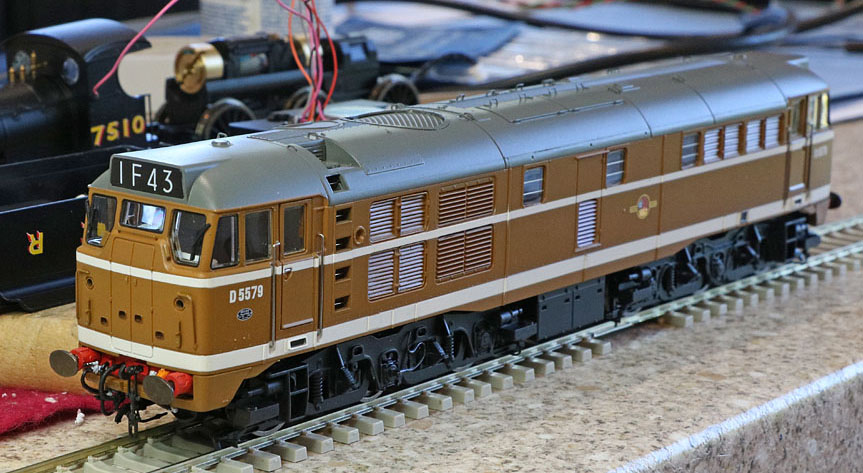
Orange-brown liveried Brush Type 2 as delivered from Kernow Models.
| The Green
Transition: Railmatch BR Green was chosen to paint over the top of the original orange/brown coloured parts of the locomotive. It proved unrealistic to remove the windows as they were very securely bonded in place, so the first task involved very carefully hand painting the window frames green, using a very fine brush.
Using very fine abrasive paper, the raised numbers and BR logos were sanded flush. The model was then masked to cover up the windows, roof and all below the top of the upper white line. Several light coats of Railmatch BR green spray paint were then applied between the roof and upper white line. When dry, the process was repeated to spray paint the area between the two white lines. Finally the area below the bottom white line received the same treatment.
The imperfections were then made good using white or green brush paint. Railtec Transfers have a complete 4mm early Brush type 2 transfer sheet that they can customise for specific numbers. D5572 has been chosen as a March based locomotive that very probably saw service through our village station. The transfers have now arrived, so next steps (after wiring up the body) are to gloss over the local area of each transfer using enamel gloss varnish. The transfers will then be applied and when they are completely dry, the whole body will be sprayed with matt varnish (except the window areas which will be masked). Finally, the cab door handrails will be glued back in place. |
| Selecting the
sound decoder: During the late 50s and first half of the 60s, A Mirrlees Diesel engine powered the Brush Type 2 locomotives. Unfortunately these engines had a disastrous record of reliability and after a successful trial, BR decided to re-equip the entire fleet of circa 200 locomotives with the English Electric engine used in the Class 37, down-rated in line with the capabilities of the Brush Type 2 generator and traction motors. The engine change was carried out in the mid 1960s. The locomotives (originally TOPS code Class 30) were reclassified as Class 31 when commissioned with the new engine. The sound recordings available for incorporation into DCC sound decoders have all been made using the remaining preserved Class 31 locomotives as no Mirrlees examples survived into the digital age. There have been attempts at simulating the original Mirrlees diesel engine sounds, but the accuracy of the results is somewhat doubtful. The Mirrlees engines used in Class 37/9 and Class 60 locomotives (6 & 8 cylinders respectively) are very different from the 12 cylinder type used in the type 2 and as a result, sound recordings from these locos are not useful for type 2 simulations. So it has been decided to use a Class 31 Legomanbiffo LokSound V4. This will later be compared with the Paul Chetter Zimo MX645 solution in my Network Rail Class 31. (If the Zimo solution is deemed more like the Mirrlees, then a swop will be considered.) A downward facing bass reflex speaker with 20x40mm drive unit will be used, located in place of the Hornby model fan assembly.
Bif's published Function Map:
The original fan mechanism has been removed from the chassis to make room for the speaker. The red fan has been weathered and glued directly to the undersideof the roof vent, using two small plasticard spacers. Diesel soot stains have been added on the roof. A 4 ohm bass reflex speaker is now mounted on the chassis. The original Hornby PCB has also been removed and replaced by a simple plasticard substrate supporting an NMRA 8 way socket with no function wire connections but including two non-NMRA standard speaker connections in their place. |
| Fitting the
electrics: The new sound decoder (and some new LED series resistors) completely replace Hornby's main PCB assembly, which is consequently removed. Previous experiments suggest that a 4 ohm DCC Supplies bass reflex speaker using a 20x40mm drive unit works well when fitted in place of the Hornby fan assembly, facing downwards. A super capacitor is used to provide a limited degree of protection against track contamination. This is a 15 volt device so over-voltage protection is provided by a simple zener diode circuit. The decoder is mounted in the body shell roof, with electrical connections to the chassis assembly, made via the modified 8 pin DCC connector, which has been customised to exclude the function control wires, but to include (non-standard) speaker wires. A warning label will be added to indicate the non-standard nature of the revised connector. Circuit Diagram: Experiments with a bench power supply provided a subjective view on the optimum series resistors to be used when powering up the LED lighting. The values are 3k9 for the rear lights, 1k for the headcode boxes and 2k2 for the cab light.
Circuit Configuration (Aux3 and Aux 4 outputs are normal function outputs on Bifs V4 variation, so buffers are not required.)
Inside the body shell. Wiring up the decoder and stay alive supercap. is under way. The blue tack blobs are being used to hold the wiring in place while the retaining glue dries.
Wiring now complete including reminders that the 8pin sockets are now not wired to NMRA rules. |
|
Transfers and cosmetics:
New Railtec transfers for D5572 are now in place and the cab door hand rails have been put back in place.
The bogies have been weathered and a there are signs of minor corrosion appearing on the lower body sides.
The Type 2 hauls a Yorkshire coal train, heading towards London. |
March 2018:
The final passenger services between Cambridge and St Ives used a variety of diesel railcars in the late 1960s.
We are preparing two examples for our next display, a Class 108 and a Cravens Class 105. Both in the British Rail Blue colour scheme, with yellow ends.
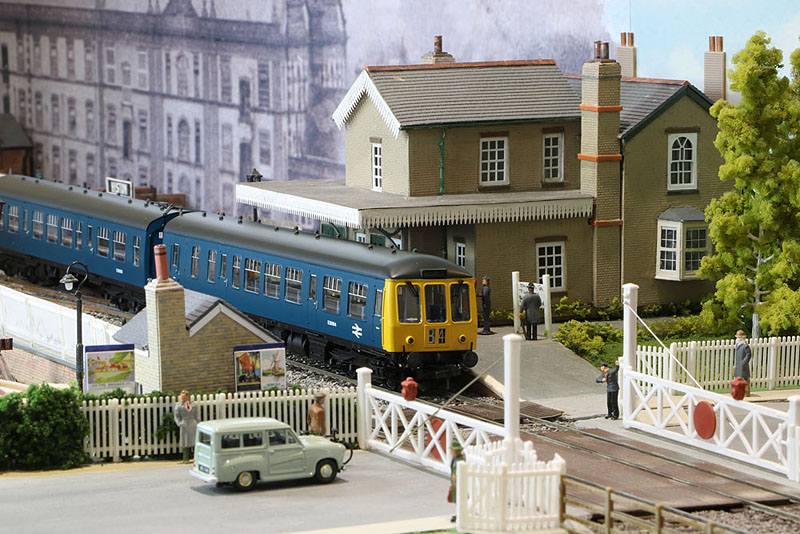
Class 108 train for Cambridge at Histon Station.
|
The need for an improved Sound system: We ran an earlier Derby Lightweight DMU (diesel multiple unit) at our last display. However the sound system was not loud enough for the low frequency diesel engine sounds to be heard clearly against the background chatter of our audience, so the first challenge for these newer DMU DCC sound conversion, is to improve the sound volume. All of these DMUs start life as off the shelf Bachmann products. The manufacturer has conveniently provided a mounting location for a DCC decoder, cast into the top of the metal motor housing within the power car. However, the only sound decoders that will fit within the limited space provided are miniature devices only capable of delivering 1 Watt of audio power into an 8 ohm loudspeaker. The earlier DMU used a Zimo MX648 decoder driving a "sugar cube" type speaker. The volume level could not be turned up higher without creating distortion in the speaker. The proposed improvements: The new DMUs will be modified to create a larger space above the motor housing, enabling a full size decoder, capable of producing approximately 3 Watts of audio power into a 4 ohm loudspeaker. Experiments suggest that an ESU 20x40mm speaker, fitted within its standard enclosure can produce a higher undistorted sound level than most of the alternative speaker types. This speaker can be concealed semi-recessed within the floor of both Class 105 and Class 108 trailer cars.
The Class 105 motor housing above has been modified to accommodate the larger decoder and the 20x40mm speaker is installed in the floor of the trailer car. |
|
Inside the passenger compartment: The original seat mouldings have floors and partitions the same dark colour as the seats. I've painted these a very pale green shade and populated the cars with a number of Noch seated figures. The original internal lights consisted of fairly dim yellow LEDs, mounted horizontally and illuminating the cabin via a clear plastic light pipe moulding, which reflected (or refracted?) the light downwards along the length of the cabin. The result was a dimly lit cabin with quite a variation in lighting levels from one end to the other. I've removed the clear plastic light pipe and the original LEDs, replacing them with a number of warmish-white chip LEDs glued to the roof PCB and facing downwards. These are much brighter than the originals, when fed via the same series resistors. I've also painted the PCB underside matt white (except for tracks available to feed additional LEDs if required.)
Inside the Class 108 trailer car. Inside the driver's cab: A Noch driver, with his clothes painted in BR uniform matt black has been glued in place of the tiny driver's seat moulding in the power car cab moulding. A warm white cab light LED is now mounted in the cab roof and powered from the decoder so that even when switched on via key 8, it automatically switches off if the train starts to move. Above the driver's cab is a white LED illuminating the destination label (a Bachmann original).
Class 108 trailer car modified internal lights in action. |
|
Setting up the DCC decoders: 1) The trailer car function decoder: The lighting control for the trailer car (directional running lights and internal passenger compartment lights) needs to be set up in order to assign the desired control buttons and specify the forward and reverse running lights behaviour. 2) The power car sound decoder The decoder arrives with the volume set to maximum, so before trying it for the first time, the volume needs to be reduced to something that wont frighten the neighbours! Next, the customised lighting arrangements need to be assigned to control buttons and several of the sounds are shuffled so that the most used sound sequences are activateded by controller keys 0 to 9. (This operation is called Function Re-Mapping.) Also, the individual sound levels e.g. the guards whistle, can all be adjusted to suit the operating environment. Finally, the motor is controlled using a back emf feedback system within the decoder, this can be optimised, to get the smoothest possible slow speed behaviour. |
|
The Destination Labels: The originals have been replaced with custom "St Ives" and "Cambridge" labels printed on ink jet photo paper, after carefully removing the original painted-on text, by scraping the rear of the display window with a wooden cocktail stick point.
|
January 2018:
A Fen Drayton Sand Train:
The last regular trains to pass through the (by then disused) Histon Station, during the 1970s and 1980s.
|
The Original Sand Train: In the later years, the early morning sand trains were hauled by BR blue Class 37 locomotives. The wagons were typically, rusty brown coloured 21 ton 4 wheel hoppers. A guards van brought up the rear and its occupant was responsible for opening and closing all the now unmanned crossing gates, between Fen Drayton Lakes and Cambridge. Photographs of the trains in operation can be seen in the East Anglian Railway Archive website. |
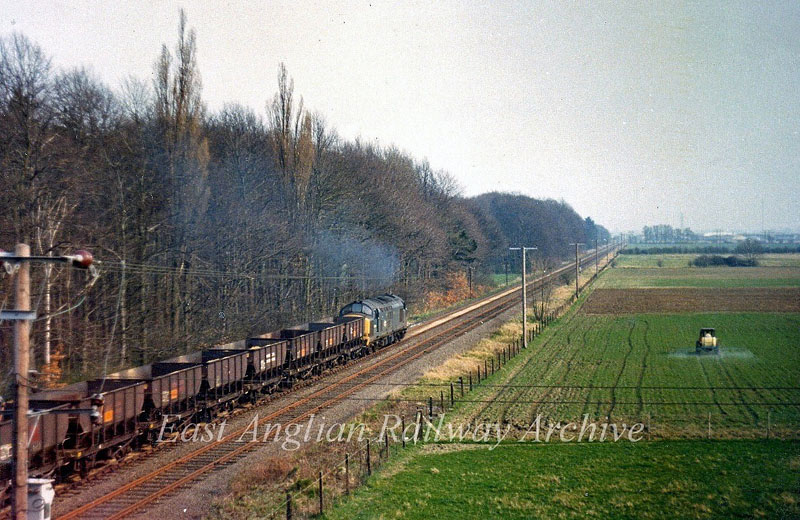
The original sand train with thanks to Alan for permission to use.
|
Our Sand Train Replica: Motive power is provided by Bachmann's recent re-release of a Class 37/0 with front marker lights housed in a pair of separate head code boxes at each end of the locomotive. Colour is blue overall with yellow ends. Dapol 21 ton hopper wagons make up the bulk of the train and a Bachmann BR brake van is coupled at the rear. The Dapol wagons arrived in pristine grey and black, with simulated coal loads on board. These have been painted in the appropriate rusty brown colour of the originals, heavily weathered and loaded with sand. The locomotive and guards van have now been lightly weathered. Our locomotive is fitted with an ESU V4 sound decoder, loaded with the latest version of Legomanbiffo's Class 37 sound project. A 20x40mm speaker is installed within the fuel tanks. The control of the running lights has been transferred to the decoder and a 6800uF stay alive capacitor with over-voltage protection circuit has also been added. |
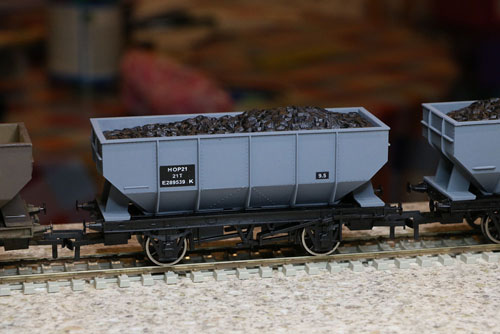 Original Dapol hopper wagon |
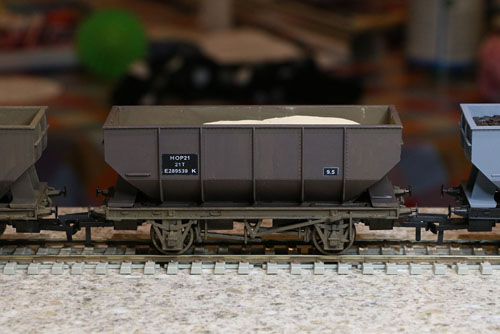 Updated Sand Train hopper wagon |

Our version of the sand train (with 6 of the 7 wagons on the hook.
December 2017 - January 2018:
A new WD Austerity 2-8-0, for the June 1944 period, ready to haul our second tank train:
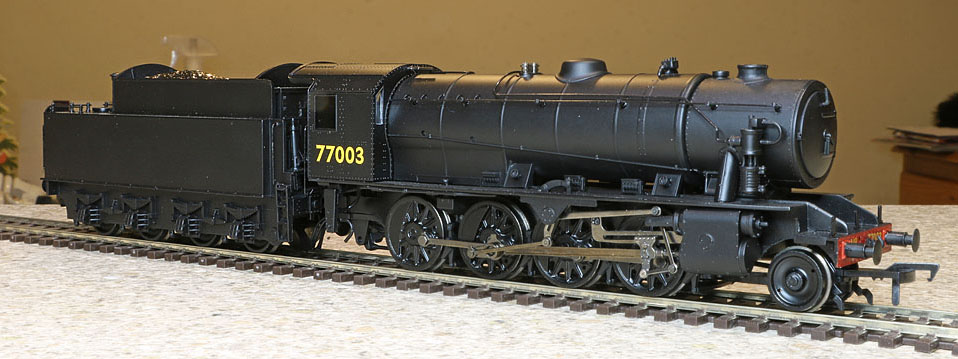
The new locomotive as received
|
Our application for the new WD: This WD will portray one of the (then newly built) 350 Riddles designed War Department locos temporarily loaned to the LNER before virtually all 900 plus WDs were shipped abroad for duty with the Army Transportation units in late 1944 and 1945. However, Bachmann's current offering has livery and markings that reflect a later period soon after the locomotives returned to the UK after completing their service abroad in circa 1946. So the first task is to research the livery and numbering arrangements of our target mid 1944 period locomotives. |
|
A bit of livery history: The WD 2-8-0s were produced at the two North British Locomotive factories in Glasgow and The Vulcan Foundry plant in Newton le Willows, with first deliveries appearing in 1943. The locomotives were initially out-shopped with a black and khaki brown paint scheme. There are very few photographs on the web that show the locomotives in this scheme and the two we have found show rather different distribution of the colours. From the end of March 1944, the livery was changed to black and khaki drab, which is a pale green hue. It is thought that the locomotives may all have been repainted in the new green colour when their original 4 digit numbers were all pre-fixed by the number 7, immediately before they left for service abroad.
Copies of the only two khaki brown livery photos found on the web, showing much more black used on the lower photo.
Original 3 or 4 digit numbers appeared on the cab sides in golden yellow. Initially as very small circa 2 inch digits, but later in increased sizes up to 8 inch. The tenders received "WD" letters and later, with the war department arrow motif in between. We have yet to identify specific numbers for the 350 locos loaned to the LNER during 1943/44. However, the choice of a black and khaki brown paint scheme should give a much greater choice of possible locomotives as this appears to have been used from early 1943 to March 1944.
A doctored Hattons Bachmann image, showing how the second scheme might look.
Two photos of obsolete past Bachmann models. Although the sand coloured loco looks similar to the North British photo at the top of this section, its difficult to believe that such a colour scheme was intended for use in Western Europe, so our scheme is based on the second period photo from the top, but uses a slightly darker shade of Khaki. |
|
The 1943 livery: I've brush painted the khaki on to the relevant parts of the boiler, cab and tender. I began with Humbrol 26 "Khaki drill" matt enamel, but then switched over to 29 "Dark Earth" to obtain a very slightly darker shade. I've now noticed that the photograph indicates a need for some additional painted areas at the cab entrance on both tender and loco, which I've now done, pending the number choice.
Just need to decide upon the number and apply that and some WD lettering, followed by some light weathering
David’s Info on the Wartime WD 2-8-0 numbers The Bachmann model of 77003 which was built 2/43 by the North British Loco Co in Glasgow from there Hyde Park factory, Order Number L943. It was one of 50 loco’s which were numbered 7000 to 7049. All of this batch were lent to the LNER in early 1943 apart from 7011,15,42-49. Of those which were lent to the LNER some were based at Peterborough, New England yard including 7006-10, 12, 19-22, 29,30,35-8 which may have worked through Histon. However, the North British Loco Co also built 300 (also Order Number L943) loco’s numbered 7150 -7449 from May 1943 to March 1944. Of these locomotives the following were allocated to March, which I think are a better bet for working the tank train.
I’ve selected 7350 as the primary candidate as references suggest that numbers in this group are most likely to use 8 inch high cab numbering (which I have available).
|
|
Decoder, speaker and stay alive capacitor arrangements: The 1950s WD austerity locomotive solution works well, so this will be duplicated.... except the Westinghouse pump sound effect needs adding for the war time period. Digitrains kindly requested a new revision of the WD sound project, including the pump sound from the originator of the sound project, Mr Chetter, who not only obliged but added extra functionality: The revised WD 2-8-0 sound project also includes a new offering of an additional engine chuff running sound set. These can be selected via the DCC controller to simulate different reverser settings and their resultant steam cut-off effect on the chuff sounds. To be able to select more than two sound sets, version 37 (or higher) of the decoder firmware is required but unfortunately, as received, the decoder was equipped with version 36. However version 37 is now available from the Zimo website, so I was able to load it and make full use of the new functionality. The locomotive is now running well, with the Westinghouse pump sound also now added to the randomly timed background sounds.
|
|
November 2017: Histon and Impington Model Rail Group Running Day 26 November 2017 On Sunday 26th November, the Histon and Impington Model Rail Group held an open running session in the St Audrey’s Close Community Centre during the afternoon for the benefit of close to 50 visitors. The layout was assembled during the morning and after dealing with a few minor technical issues, the group was able to test run a number of the trains around the layout before snatching a quick lunch break prior to the afternoon opening time. The display began by running a range of 1935, LNER period trains, all digitally controlled and sound equipped. (The locomotives are all fitted with digital decoders incorporating sound generation electronics connected to miniature on-board loudspeakers.) Next, the time period changed to 1944, with a train carrying imported American Sherman tanks to the US Army Technical Centre on the site of the present Science Park near Milton. Peace returned to the Community Centre with a range of early British Railways passenger and freight trains from the 1950s. Finally, the diesel age arrived with a mix of 1960s diesel railcars and a Deltic main line diesel diverted through Histon due to engineering work on the East Coast Main Line. Thanks to Ann for providing refreshments to our visitors and to Geoffrey for organising the Village Society Station Booklet re-print …… We hope everyone enjoyed their afternoon with the trains!Some of the Locomotives and Trains on display:
B17/6 in 1930s LNER Green
D16/3 in 1930s LNER livery (shown above with non-representative Mk1 test coaches.)
Midland Class 3F in 1930s LMS colours
J15 Locomotive in 1930s LNER livery
Class O4 Heavy freight 2-8-0 in 1930s LNER livery
LNER Class K3 locomotive in wartime "NE" livery hauling M10 armoured vehicles
BR WD Austerity 2-8-0 locomotive hauling coal empties in the 1950s
These locos soldiered on long after their design life cycle right up to the end of steam.
EE Deltic Diesel locomotive diverted from the ECML due to engineering work |
|
September 2017: Further layout enhancement possibilities: More detail on the proposals is provided below: Careful studies of our more recent aerial photos have given a better understanding of the track layout in and around Histon Station. The drawing below summarises the findings and can be used as the basis for further improvements to the layout.
If safe storage space can be identified, extension boards can be created at the rear of the original layout board to incorporate the three Chivers sidings. Also a West side extension would incorporate some key pointwork and the cardboard factory siding. Some additional modifications would be needed to the original layout and the cassette board in support of the improved track solution and possible approaches are shown below. Adding a rear extension:
The original layout board is shown in pale green and the cassette interface panel is in grey. This would enable Chivers van and coal traffic to be included in the display, but the sidings can only be accessed via the cassette system. The direct access from the Cambridge bound through line to the short siding behind the North platform is a deliberate minor distortion of the real layout, to support more interesting operational shunting activities. Although not shown in the diagram, the Chivers buildings and the station goods yard, with its access lane from Station Road can be modelled fairly accurately within this scheme.
Additionally, adding a West extension:
The pale blue area is the proposed new West extension board. This arrangement facilitates access to the Chivers sidings to and from the main up and down lines as well as via the cassette board. It also includes a much more representative model of the South sidings with their long head shunt that also acts as an access siding to the cardboard factory.
Outline board design and detailed material cost estimates have been prepared for both of the above extension projects, but a lack of storage space may mean that these are just academic exercises. |
|
August 2017: A new 1950s Kettering to Cambridge Midland Region train to run: Bachmann have just re-released their Ivatt Class 2MT in early crest British Railways livery to provide us with motive power for the Kettering trains passing through Histon Station in the 50s.
I've just completed a DCC sound conversion and the loco is running well. Three maroon and cream Mark one coaches complete the train.... all we need now is another cassette box to carry it in.
The tender has limited internal space, so I've used a small "sugar cube" style speaker and a miniature sound decoder (MX648). This leaves plenty of room for an AVX 6800uF 15 Volt "stay alive" capacitor, which I've equipped with the usual zener diode based charge voltage protection circuit.
|
|
What Next?: (August 2017) We have started to ponder on possible further developments to the layout before our next display........ but, we have the dual problems of funding any new construction and storing any additional boards and their supports. So its quite likely that this year will be one of consolidation, rather than further development.Preliminary costings have been done for a new rear board, to house the 3 Chivers factory sidings and for an additional board between the cassette table and the original layout. This will give us some figures to discuss. In the mean time some additional members locomotives and rolling stock are becoming available to run on the layout and we have been finding out more about possible main line diversions through the village, which could extend the choice of future models to run. Our steam locomotives normally need to be converted to permit DCC control and sound operation. This is done by fitting sound equipped DCC decoders and installing miniature loudspeakers within the locomotive or tender. We generally also fit a "stay alive" capacitor circuit, which helps the locomotive run through any electrical track discontinuities, without hesitating. To add realism, a driver and fireman are also normally glued in place on the footplate. A new LNER green liveried Class B12....... has just been modified in this way:
The new sound locomotive with 3 period teak coaches.
A close up of the locomotive showing the crew on-board. A real full size green liveried LNER Class B12 locomotive can currently be seen operating on the North Norfolk preserved Railway line. This sparked the decision to add the locomotive to the fleet.
Some new, possible 40s Period Rolling stock:
Newly released "Warwell" 50 ton wagons introduced during WW2 for carrying American produced tanks.
A close-up of the wagon and its load.... an Airfix Sherman tank modified as a Sherman Firefly, mounting the high velocity 17 pounder gun.
Main Line Diversions..... opening up our choice of locomotives?: Route Availability was the system used by the LNER and later adopted by BR, to identify which locomotives and rolling stock were compatible with each stretch of railway track. The limiting factors were mainly the strength of the bridges that support the track. Each locomotive was assigned a corresponding figure (mainly relating to weight and axle loading) and to be cleared for travel on a section of track, the locomotive route availability had to be equal to or less than the track section figure. During LNER days, we understand that the route from March and St Ives, through Histon to Cambridge, that would be used by any diverted main line trains, had a Route Availability (or RA) of 7. Unfortunately, the big LNER steam locos such as Mallard and Flying Scotsman, had an RA of 9, which means that these would have to be diverted instead via Ely and would not have come through our village station. However, during the late 1960s or early 1970s, the author WAS diverted through Histon when in a London bound main line train, hauled by a main line diesel..... so at least some ECML diversions did come through and can legitimately be modelled. So more about this later..............
|
|
The First Public Outing For Our Updated Layout: (July 2017)
We had been invited to display the new layout at the St Andrews Church Hall on Feast Week Sunday. Fortunately, it all went rather well (complete understatement!) Lots of interest from our village audience and miraculously it all behaved faultlessly for the entire display....a period of over 5 hours! This was the first time that we had used the cassette mount / dismount arrangements and the return loop for an extended period and we were very happy with the outcome! A visiting camera team from Channel 4 television even took quite a bit of interest, and used a fair bit of video memory..... but I will be most surprised if we actually get any air time! A few photos taken on the day:
As a result of
our all too brief rehearsal in the Salvation Army Hall, it was
decided to exclusively run our own DCC sound locomotives during
the display. Although the electrics will support traditional DC
or digitally controlled DCC, there is a danger of damaging any
DC locomotives accidentally left on the active track during DCC
operation. We decided that in our first exposure to a display
environment, the danger was best avoided. We also kept to
a 1930s time frame, although in future we plan to add operations
using locomotives and rolling stock from the 40s, 50s and 60s
periods.
So our display
line up trains were all DCC controlled and used on-board sound
systems. Some were also fitted with working lights and
firebox glow.
The 1930s trains
used in the display were:
An LNER "Claud
Hamilton" Class D16/3 pulling 3 Gresley suburban coaches.
An LNER "Sandringham"
Class B17/6 pulling 3 Gresley corridor coaches.
An LNER Class O4
2-8-0 goods loco, hauling a long coal train.
An LNER Class J15
light goods loco pulling a local drop-off goods train.
An LMS
Class 3F pulling 3 Midland suburban coaches. (This provided our
Midland presence, operating
between Cambridge and Kettering through Histon).
|
|
Developing the Layout: (Late 2016 through to June 2017) During late 2016 and early 2017, a considerable transformation has taken place: A New track layout: We have been working towards a track layout that is much closer to the real Histon station, as it was in the period from 1930 to the 1960s. A key enhancement was to create through up and down main lines, so that with feeder/recovery tracks on either side of the main layout, we can run a range of models representing through rail traffic via a working level crossing to better illustrate the range of trains and locomotives seen on the line in its heyday. We have created models of the Histon wooden goods shed, with its adjacent office building. Also the well known Crossing keeper's hut. Our new layout allows these and the original signal box to be placed in their correct locations. A low relief model of the Railway Vue public house has also been created near to our new level crossing. We use a cassette system on the West side of the layout, to feed and recover trains on and off the layout. On the East side of the layout, our new boards include the Histon level crossing, Railway Vue public house and an exit tunnel that can be converted into the 1963 road bridge by the simple removal of tree camouflage. A hidden return loop allows Cambridge bound trains to be re-introduced on the St Ives bound line after a pause to simulate the Cambridge turn-around. Pointwork also facilitates more simple out and return operation of reversible diesel railcars.
The back-Scene has been changed to a much enlarged period photograph of the enormous Chivers factory that once dominated the station area.

Showing the new
back scene and track layout, including the wooden goods shed,
with the signal box now in its correct position.
Photos showing
the cassette loading system and the return loop:
A New Control
Regime:
To make it
possible to run a wider range of rolling stock on the layout,
the revised layout electrics have been redesigned to operate on
either the traditional 12 Volts DC of the original layout, or to
be operated via Digital Command & Control (DCC) which enables
independent operation of several locomotives simultaneously and
adds the possibility of sound reproduction and train
lighting.
The points
controller has also been updated to control the new layout,
using switches to replace the original probe and contact system.
The updated box also includes comprehensive isolation switching
for use when operating in traditional DC mode.
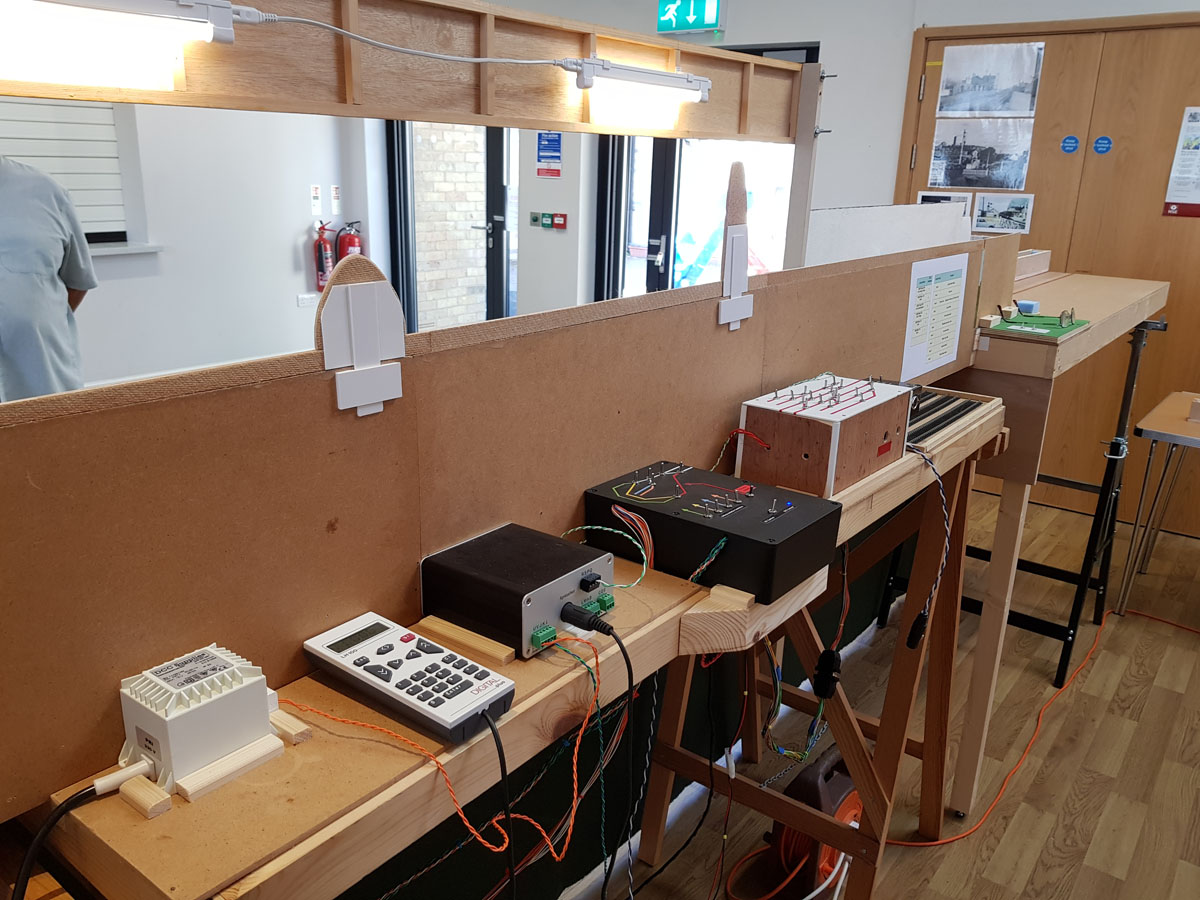
Our new "Mission
Control" showing the Lenz DCC controller, the new return loop
control box and the updated
original points and track control box.
Funding the modifications:
Our thanks go to
the Village Feast Committee for agreeing to fund the majority of
the track layout enhancements including the new cassette system
and return loop boards with the updated points control systems.
(The DCC
controller and DCC trains on display are loaned for specific
events by the group members.)
Please see the July 2017
entry above to see how the first display of the much modified
layout went...........
|
|
A little research from period photos of the real Histon Station in times gone by: (July 2016) To compress the key elements of Histon Station into an exhibition friendly 7 ft by 18 inch layout, Graham had to take quite a few liberties with the choice of buildings and their location. It certainly gave a flavour of Histon, but with the help of our Village History experts, we are trying to develop the layout into a more accurate picture of how the station area really looked, in a way that makes operation of the layout as interesting as possible (both to our audience and ourselves :-) during village events.
This diagram illustrates the approximate track plan of Histon Station and its yards at the time period of our layout. We can't squeeze it all into the space we have available, but we are endeavouring to make it as realistic as we can.
We hope to eventually add a narrow rear section to the main board, to allow the Chivers loading bay sidings to be included........ but that is for the future! |
The original layout, as received in mid 2016
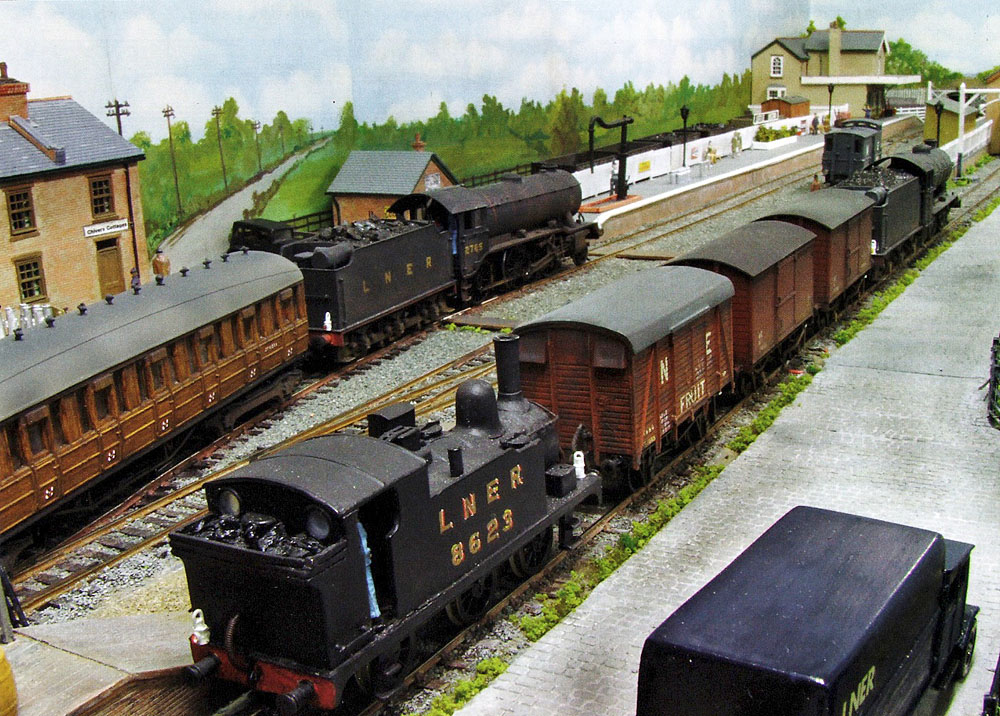
The original layout as received in May 2016
|
Summary: Little Histon is a 1/76 scale model railway layout acquired for the village in May 2016. It portrays Histon station in 1934, with period locomotives and rolling stock.
A bit more detail: The “Little Histon” Model Rail layout has recently been retired from the exhibition circuit and now resides within the village that provided the inspiration for its creation (by Graham Tandy & Mike Duffield). The setting is 1934, when the railway station formed part of the LNER network. The station is situated on the Cambridge to St Ives branch line. Regular passenger trains served the line, while Chivers jam factory created a huge amount of freight traffic. The local coal merchant “Percy Pegg” also had a dedicated siding. To misquote Eric Morecambe: “The buildings are there….. but not necessarily in the right place”! Some liberties have been taken to compress the scene into an 8 ft x 18 inches exhibition layout. So an additional challenge is to identify the buildings and remember where their true locations are (or were) within the village. The Histon & Impington Model Rail Group is being created initially to maintain, enhance and run the layout at village events…. But if there is sufficient local interest in railway modelling, it is hoped that this will also provide a focus for enthusiasts with wider model rail interests, to meet and share ideas. |
|
A few technical details for the original layout:
Taken from an article by Graham Tandy, who built the layout |
|
Our Initial Locomotives & Rolling Stock: (All locomotives are DC controlled)
|
Click here for a brief video of our first village demonstration.
With thanks to Graham and Mike for coming along and sharing their expertise!
| Click to move to Loco-Updates menu page |